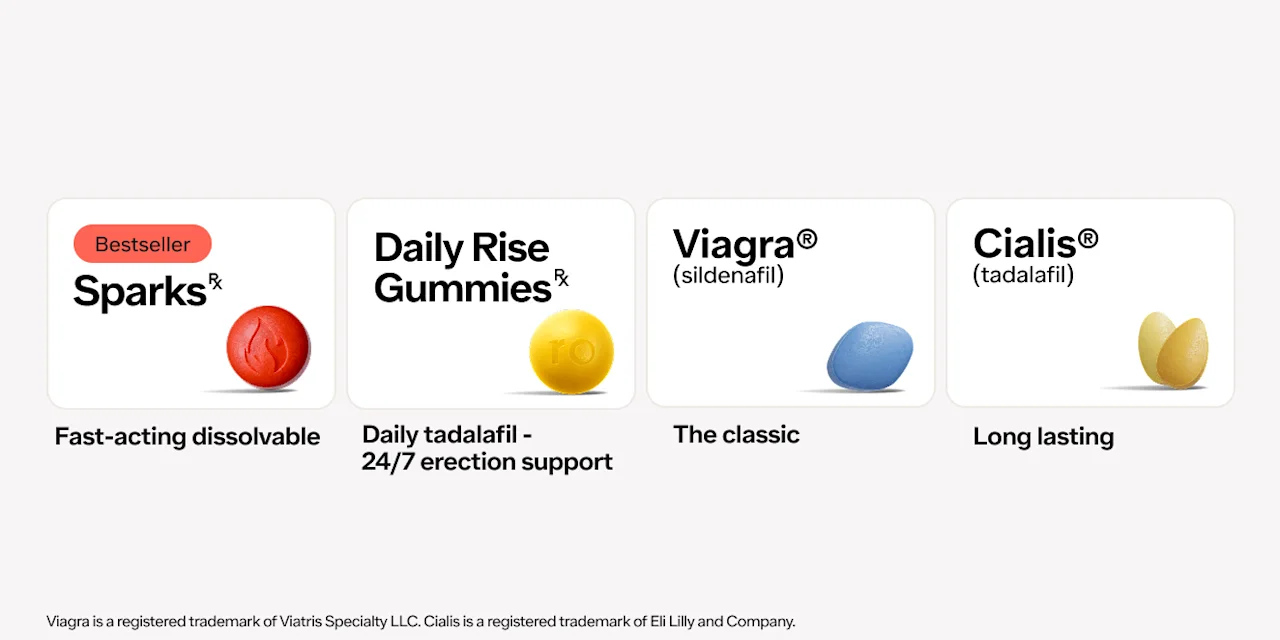Here's what we'll cover
Here's what we'll cover
There are a number of prescription medications available for the treatment of erectile dysfunction (ED). Overall, they are relatively safe and very effective at restoring sexual function. These drugs include sildenafil (brand name Viagra), tadalafil (brand name Cialis), avanafil (brand name Stendra), and vardenafil (brand names Levitra and Staxyn). Known as PDE5 inhibitors, they all work in a similar way and have similar side effects (Schwartz, 2010).
PDE5 inhibitors work by blocking a natural enzyme known as PDE5, which serves as an erection's “off” switch. PDE5 tells blood vessels to constrict, causing blood to drain out of the penis, returning it to its flaccid state. When PDE5 is blocked by these drugs, it allows for a harder, more prolonged erection.
Some common side effects of PDE5 inhibitors include flushing, congestion, vision changes, muscle aches, and upset stomach. That said, they are generally well tolerated. If you are taking nitrates (such as nitroglycerin, isosorbide, nitroprusside, or amyl nitrite), you cannot take PDE5 inhibitors as the combination can be life-threatening (Schwartz, 2010). You should always consult with your healthcare provider before trying a new medication and purchase your medication from a reputable pharmacy.
Side effects or reactions to these medications can depend on the dosage. If you experience side effects while taking ED medication, talk with your healthcare provider. They may be able to adjust your dosage or choose a different ED medication that is right for you.
What causes ED?
ED is when a person can't achieve or maintain an erection sufficient for satisfying sex. This can take the form of erections that happen less frequently or are less firm than you'd like.
ED is the most common sexual dysfunction there is. Experts believe that more than 30 million American men have experienced it at some point (Nunes, 2012). Erectile dysfunction can happen at any age, but it becomes more common with age. By the time a man is in his 40s, he has about a 40% chance of having experienced ED. That percentage increases by about 10% for each successive decade of life (Ferrini, 2017).
That said, ED is not considered to be a natural part of aging. It can often be a sign of a more dangerous underlying medical issue, including:
Heart disease: The most common cause of erectile dysfunction in men over 50 is atherosclerosis, or hardening of the arteries (Cleveland Clinic, n.d.). As arteries stiffen or narrow, blood flow is reduced throughout the body, including to the penis, thereby hindering erections (American Heart Association, n.d.).
High blood pressure (hypertension): In this condition, blood pumps through blood vessels more forcefully than it should, potentially damaging and narrowing the vessel walls and restricting blood flow (American Heart Association, n.d.).
Diabetes: High blood sugar associated with diabetes also can damage the walls of blood vessels, impeding blood flow (American Diabetes Association, n.d.).
Stroke: A stroke can result in neurological damage that can contribute to ED (Koehn, 2019).
Cancer: A variety of physical and psychological issues related to cancer symptoms, surgery, and treatment can contribute to ED (American Cancer Society, n.d.).
Anxiety and depression: Depression, anxiety, and other psychological issues such as relationship problems and performance anxiety can all contribute to ED (Rajkumar, 2015)
Treatments for ED include oral medications; non-oral medications that are injected into the penis, causing an erection (alprostadil, BiMix, TriMix), lifestyle changes (such as eating better, getting more exercise, quitting smoking, drinking less alcohol, and losing weight); surgery (used to resolve specific issues contributing to the development of ED such as Peyronie’s disease); devices such as cock rings and penis pumps; counseling to resolve anxiety, depression or other issues that might be contributing to ED.
Which ED medication is best for me?
Deciding what ED medication is best for you depends on a number of factors, including:
Price/insurance coverage
Interactions with other medications you're taking
Dosages
How long it lasts
Talk with a healthcare provider about what ED medication might be best for you.
DISCLAIMER
If you have any medical questions or concerns, please talk to your healthcare provider. The articles on Health Guide are underpinned by peer-reviewed research and information drawn from medical societies and governmental agencies. However, they are not a substitute for professional medical advice, diagnosis, or treatment.
Viagra Important Safety Information: Read more about serious warnings and safety info.
Cialis Important Safety Information: Read more about serious warnings and safety info.
American Cancer Society. How Cancer Can Affect Erections. (n.d.). Retrieved Aug. 23, 2020, from https://www.cancer.org/treatment/treatments-and-side-effects/physical-side-effects/fertility-and-sexual-side-effects/sexuality-for-men-with-cancer/erections-and-treatment.html
American Diabetes Association. Erectile Dysfunction. (n.d.). Retrieved Aug. 23, 2020, from https://www.diabetes.org/resources/men/erectile-dysfunction
American Heart Association. How High Blood Pressure Can Affect Your Sex Life. (n.d.). Retrieved Aug. 23, 2020, from https://www.heart.org/en/health-topics/high-blood-pressure/health-threats-from-high-blood-pressure/how-high-blood-pressure-can-affect-your-sex-life
Erectile Dysfunction & Heart Disease. (n.d.). Retrieved from https://my.clevelandclinic.org/health/diseases/15029-heart-disease--erectile-dysfunction
Ferrini, M. G., Gonzalez-Cadavid, N. F., & Rajfer, J. (2017). Aging related erectile dysfunction-potential mechanism to halt or delay its onset. Translational Andrology and Urology , 6 (1), 20–27. https://doi.org/10.21037/tau.2016.11.18. Retrieved from https://tau.amegroups.com/article/view/13319/13808
Koehn, J., Crodel, C., Deutsch, M., Kolominsky-Rabas, P. L., Hösl, K. M., Köhrmann, M., Schwab, S., & Hilz, M. J. (2015). Erectile dysfunction (ED) after ischemic stroke: association between prevalence and site of lesion. Clinical Autonomic Research : Official Journal of the Clinical Autonomic Research Society , 25 (6), 357–365. https://doi.org/10.1007/s10286-015-0313-y. Retrieved from https://link.springer.com/article/10.1007%2Fs10286-015-0313-y
Nunes, K. P., Labazi, H., & Webb, R. C. (2012). New insights into hypertension-associated erectile dysfunction. Current Opinion in Nephrology and Hypertension, 21 (2), 163–170. doi: 10.1097/mnh.0b013e32835021bd. Retrieved from https://pubmed.ncbi.nlm.nih.gov/22240443/
Rajkumar, R. P., & Kumaran, A. K. (2015). Depression and anxiety in men with sexual dysfunction: a retrospective study. Comprehensive Psychiatry , 60 , 114–118. https://doi.org/10.1016/j.comppsych.2015.03.001. Retrieved from https://www.sciencedirect.com/science/article/abs/pii/S0010440X15000346?via%3Dihub
Schwartz, B. G., & Kloner, R. A. (2010). Drug Interactions With Phosphodiesterase-5 Inhibitors Used for the Treatment of Erectile Dysfunction or Pulmonary Hypertension. Circulation, 122, 88-95. Retrieved from https://www.ahajournals.org/doi/10.1161/CIRCULATIONAHA.110.944603










